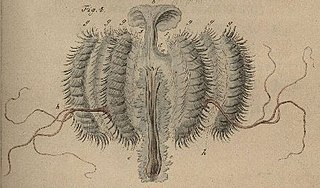
Cydippida is an order of comb jellies. They are distinguished from other comb jellies by their spherical or oval bodies, and the fact their tentacles are branched, and can be retracted into pouches on either side of the pharynx. The order is not monophyletic, that is, more than one common ancestor is believed to exist.

Callianira hexagona is a species of ctenophore of the family Mertensiidae. The scientific name of this species was first published in 1789 by Bruguière.

Euplokamis is a genus of ctenophores, or comb jellies, belonging to the monotypic family Euplokamididae. It shares the common name sea gooseberry with species of the genus Pleurobrachia. After being originally described by Chun (1879), the family Euplokamididae was expanded by Mills (1987) due to the discovery of a new species, Euplokamis dunlapae. Further research indicated that Euplokamis should be identified from Mertensiidae due to the rows of combs and some compression. They may also be distinguished from the genus Pleurobrachia due to their more elongated shape. Additionally, various adaptations of Euplokamis have been observed such as the use of tentacles for movement/feeding, a complex nervous system, and bioluminescent capabilities. Other characteristics including a defined mesoderm, lack of stinging cells, developmental differences, and symmetry supported the reclassification of these organisms.

Callianira is a genus of ctenophores belonging to the family Mertensiidae.

Callianira bialata is a species of comb jelly within the family Mertensiidae. Comb jellies are gelatinous marine invertebrates characterized by rows of ciliary plates, known as comb rows, which they use for locomotion. Specific morphological details about C. bialata are limited in the provided sources.

Callianira cristata is a species of ctenophore of the family Mertensiidae. They have been discovered in the Southern Ocean.
Charistephane is a monotypic genus of ctenophores belonging to the family Mertensiidae. The only species in this genus is Charistephane fugiens.






